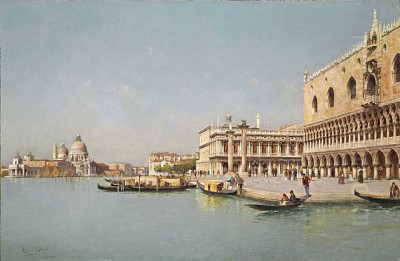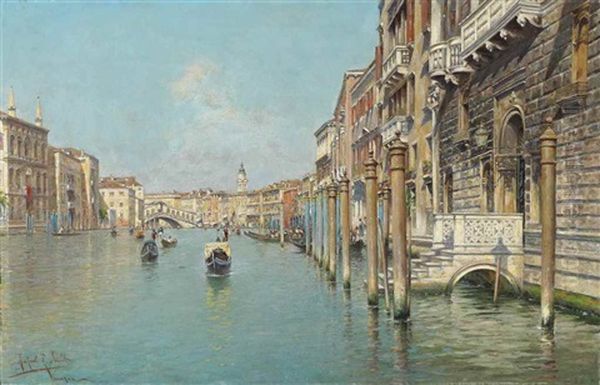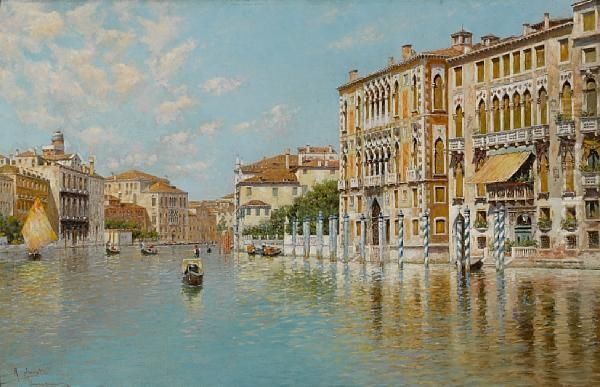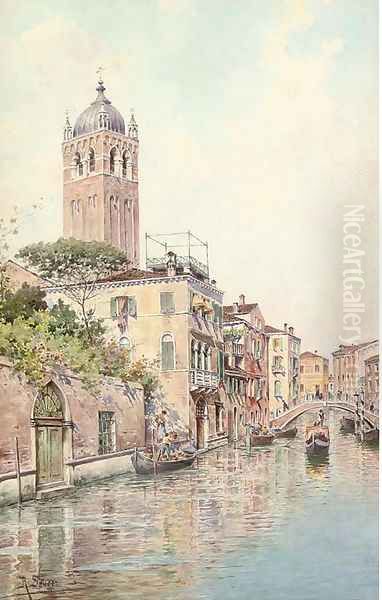
Rafael Senet y Pérez stands as a distinguished figure in the annals of late 19th and early 20th-century Spanish art, celebrated primarily for his evocative and sun-drenched depictions of Venice. Born in Seville on October 7, 1856, and passing away in 1926, Senet y Pérez carved a niche for himself as a master of the Venetian veduta, or view painting, capturing the unique interplay of light, water, and architecture that defines the iconic Italian city. His work, characterized by meticulous detail, vibrant colour palettes, and a keen observational skill, not only brought him contemporary acclaim but also secured his place among the notable European painters who found their muse in the canals and palazzi of La Serenissima.
Early Life and Artistic Foundations in Seville
Rafael Senet y Pérez's artistic journey began in his native Seville, a city with a rich artistic heritage that had nurtured masters like Diego Velázquez and Bartolomé Esteban Murillo centuries before. He enrolled at the prestigious Seville Academy of Fine Arts (Escuela de Bellas Artes de Sevilla), an institution that played a crucial role in shaping the artistic landscape of Andalusia. During his formative years, Senet was fortunate to study under influential figures who were prominent in the Sevillian art scene.
Among his notable instructors were Joaquín Domínguez Bécquer, a respected painter known for his historical scenes, portraits, and costumbrista works depicting local customs and manners. Bécquer's emphasis on careful draughtsmanship and traditional techniques would have provided Senet with a solid academic grounding. Another significant teacher was Eduardo Cano de la Peña, a history painter and portraitist who also served as a director of the Museum of Fine Arts of Seville. Cano's academic rigor and his own success in national exhibitions would have set a high standard for his students.

The artistic environment in Seville during the latter half of the 19th century was vibrant, with a continued appreciation for realism and a growing interest in landscape and genre painting. Senet y Pérez would have been exposed to these currents, honing his skills in drawing, composition, and the use of colour. This foundational training in Seville was instrumental in developing the technical proficiency that would later define his meticulous Venetian scenes.
Broadening Horizons: Madrid and the Prado's Influence
Seeking to further his artistic education and expose himself to a broader range of influences, Rafael Senet y Pérez made the pivotal decision to move to Madrid. The Spanish capital offered access to the Royal Academy of Fine Arts of San Fernando, but more importantly, it was home to the Prado Museum. The Prado, with its unparalleled collection of Spanish masters like Velázquez, Goya, and El Greco, as well as significant holdings of Italian and Flemish art, served as an essential school for aspiring artists.
In Madrid, Senet y Pérez dedicated himself to studying the works of these great masters. Copying and analyzing their techniques was a traditional and highly effective method of learning for artists of his generation. The Prado's collection would have offered him profound lessons in composition, the handling of light and shadow (chiaroscuro), colour theory, and the depiction of textures and atmosphere. The luminous qualities in Velázquez's work, the dramatic intensity of Goya, and the rich colour palettes of Titian and Rubens, all housed within the Prado, undoubtedly left an indelible mark on his artistic sensibility.
This period of intense study in Madrid was crucial for Senet's development. It allowed him to absorb the lessons of the past while refining his own artistic voice. The discipline gained from copying masterpieces and the exposure to diverse artistic styles equipped him with a versatile skill set that he would later apply to his chosen specialty: the landscape and cityscape.
The Italian Sojourn: Rome and the Allure of Venice
In 1881, following a path well-trodden by ambitious European artists for centuries, Rafael Senet y Pérez embarked on a journey to Italy. This was often seen as a capstone to an artist's education, offering direct encounters with classical antiquity and the masterpieces of the Renaissance and Baroque periods. His initial destination was Rome, the eternal city, which had long been a magnet for painters and sculptors. In Rome, he would have immersed himself in the study of ancient ruins, Renaissance frescoes, and Baroque architecture, further enriching his visual vocabulary.

After his time in Rome, Senet y Pérez traveled extensively throughout Italy, visiting key artistic centers such as Florence, with its Uffizi Gallery and Pitti Palace, and Naples, with its stunning coastal scenery and archaeological sites like Pompeii. However, it was the city of Venice that would ultimately capture his artistic imagination and become the central focus of his mature work.
Venice, with its unique urban fabric woven from water and stone, its shimmering light, and its romantic decay, presented an irresistible challenge and inspiration. The city had already been immortalized by generations of artists, from Canaletto and Francesco Guardi in the 18th century to J.M.W. Turner in the early 19th. By the time Senet arrived, Venice was a popular destination for artists and tourists alike, part of the Grand Tour circuit, and its views were in high demand.
Capturing La Serenissima: Artistic Style and Techniques
Rafael Senet y Pérez developed a distinctive style for his Venetian vedute that combined meticulous realism with a vibrant, almost luminous, use of colour. His paintings are characterized by their clarity, precision, and an ability to capture the specific atmospheric conditions of Venice – the bright Mediterranean sunlight, the hazy mornings, or the golden glow of late afternoon.
His technique involved careful observation and detailed preliminary sketches, often executed on-site. He paid close attention to architectural details, rendering the intricate facades of palazzi, churches, and bridges with remarkable accuracy. This precision, however, was not merely photographic; it was infused with an artistic sensibility that selected and emphasized elements to create a harmonious and engaging composition. Works like "On the Grand Canal, the Rialto Bridge beyond, Venice" exemplify this, showcasing his skill in depicting complex architectural forms while also capturing the bustling life of the canal.
Senet's handling of light and water was particularly masterful. He excelled at portraying the reflective qualities of the canals, capturing the shimmering interplay of light on the water's surface and the subtle gradations of colour in the reflections of buildings. His skies are often clear and bright, contributing to the overall sense of luminosity that pervades his Venetian scenes. The palette he employed was rich and varied, capable of conveying both the brilliance of a sunny day and the more subdued tones of an overcast sky.
His brushwork was generally controlled and precise, allowing for a high degree of finish, which appealed to the tastes of the contemporary art market, particularly international collectors who sought beautifully rendered souvenirs of their travels.
Key Themes and Subjects in Senet's Oeuvre

While Venice was undoubtedly his primary muse, Rafael Senet y Pérez's body of work also included other subjects, reflecting his broader artistic interests and travels.
Venetian Vedute: This was his forte. He painted numerous views of the Grand Canal, featuring iconic landmarks such as the Rialto Bridge, Santa Maria della Salute, the Doge's Palace, and the Ca' d'Oro. He also explored quieter, more intimate scenes of smaller canals (rii), picturesque campi (squares), and gondolas gliding through the waterways. These paintings often included figures – gondoliers, locals, and tourists – which added a sense of life and scale to the urban landscapes. Titles like "The Grand Canal" and "Venice, the Grand Canal, looking towards Santa Maria della Salute" are typical of this genre.
Other Italian Landscapes: His travels in Italy also resulted in paintings of other locations. While less numerous than his Venetian works, these demonstrate his ability to capture the essence of different Italian settings. "Campillo de San Zenón" (possibly a rendition of a Venetian Campo like San Zaccaria or a scene from another Italian town) and general scenes titled "Mediterranean" suggest a broader engagement with the Italian landscape and coastal views.
Orientalist Influences: Like many European artists of the 19th century, Senet y Pérez was touched by the vogue for Orientalism – the depiction of subjects from North Africa, the Middle East, and Asia. While not a primary focus, he did produce some works in this vein, such as "Portrait of an Arab Man" and watercolors depicting Arab soldiers. These pieces often showcased a similar attention to detail and an interest in exotic costumes and settings, reflecting a widespread fascination with cultures perceived as "other" by Europeans of the time. This interest was shared by Spanish contemporaries like Mariano Fortuny, whose Orientalist works were highly influential.
Representative Works: A Closer Look
Several paintings stand out as quintessential examples of Rafael Senet y Pérez's artistry:
"On the Grand Canal, the Rialto Bridge beyond, Venice": This work is a classic example of his Venetian vedute. It typically features a dynamic view along the Grand Canal, with gondolas and other boats enlivening the foreground, leading the eye towards the iconic Rialto Bridge in the distance. Senet's skill in rendering the architecture, the play of light on the water, and the bustling atmosphere of the canal is fully evident.
"Venice, the Grand Canal, looking towards Santa Maria della Salute": Another iconic Venetian view, this composition focuses on the majestic dome of the Basilica di Santa Maria della Salute, a prominent landmark at the entrance of the Grand Canal. Senet would have captured the grandeur of the church, often contrasting its white Istrian stone with the blue of the sky and water, and meticulously detailing the surrounding palazzi.
"The Grand Canal": Many of his works bear this general title, each offering a unique perspective or atmospheric condition along Venice's main waterway. These paintings collectively demonstrate his deep familiarity with the city and his ability to find endless inspiration in its varied aspects.
"A Venetian Backwater" or similar titles depicting smaller canals: Beyond the grand vistas, Senet also painted the more intimate and often quieter scenes of Venice's labyrinthine network of smaller canals. These works often highlight the picturesque decay and the daily life of the city away from the main tourist thoroughfares, showcasing a different facet of Venetian charm.
These representative works, and many others like them, are characterized by their bright, clear light, meticulous detail, and an almost tangible sense of place, transporting the viewer to the sunlit waterways of Venice.
The Sevillian Circle and Contemporary Artists
Upon his return to Seville in the early 1890s, Rafael Senet y Pérez became part of a circle of artists, notably forming a landscape painting group with Emilio Sánchez Perrier (1855-1907). Sánchez Perrier, also a Sevillian, was renowned for his highly detailed and atmospheric landscapes, particularly river scenes and views of Andalusia and Venice. Their association suggests a shared artistic sensibility and a mutual interest in capturing the nuances of light and environment. This group would have fostered artistic exchange and contributed to the vitality of the landscape tradition in Seville.
Senet y Pérez's career unfolded during a period rich in artistic talent, both in Spain and internationally. Among his Spanish contemporaries who also achieved recognition for landscape or realist painting were:
Martín Rico y Ortega (1833-1908): A highly successful painter, Rico y Ortega also specialized in luminous cityscapes and landscapes, particularly of Venice and Paris. His style, characterized by brilliant light and meticulous detail, shares affinities with Senet's work, and he was one of the most internationally acclaimed Spanish artists of his time.
Mariano Fortuny y Marsal (1838-1874): Though he died relatively young, Fortuny was a towering figure whose virtuoso technique, brilliant colours, and popular Orientalist and Rococo-revival genre scenes had a profound impact on Spanish art. His influence extended to many artists of Senet's generation.
Joaquín Sorolla y Bastida (1863-1923): A younger contemporary, Sorolla became Spain's leading Impressionist painter, celebrated for his sun-drenched beach scenes and portraits. While stylistically different, Sorolla shared Senet's fascination with capturing the effects of light.
Darío de Regoyos (1857-1913): An Asturian painter who was one of the few Spanish artists to embrace Post-Impressionist styles, Regoyos offered a different, more avant-garde approach to landscape.
Aureliano de Beruete (1845-1912): A prominent landscape painter influenced by the Barbizon School and later by Impressionism, Beruete focused on the landscapes of Castile.
In Venice, Senet y Pérez was part of an international community of artists drawn to the city. Contemporaries who also famously depicted Venice include:
Federico del Campo (1837-1923): A Peruvian painter who spent most of his career in Venice, del Campo was renowned for his highly detailed and commercially successful Venetian vedute, similar in style and subject matter to Senet's.
Rubens Santoro (1859-1942): An Italian painter who also specialized in meticulously rendered Venetian scenes, often with a romantic atmosphere.
John Singer Sargent (1856-1925): The celebrated American portraitist also produced a remarkable series of watercolors and oil paintings of Venice, capturing the city with a more fluid, Impressionistic touch.
James McNeill Whistler (1834-1903): The American artist created a significant body of etchings and pastels of Venice, focusing on atmospheric effects and subtle tonal harmonies.
Walter Sickert (1860-1942): A British painter who spent considerable time in Venice, Sickert depicted the city with a darker, more melancholic palette, often focusing on its less glamorous aspects.
Anders Zorn (1860-1920): The Swedish master painter also visited Venice and captured its scenes with his characteristic bravura brushwork and vibrant depiction of water and light.
Giovanni Boldini (1842-1931): While primarily a portraitist, this Italian artist, active in Paris, also painted Venetian scenes with his distinctive flamboyant style.
The presence of such a diverse group of artists in Venice created a stimulating environment, though it also meant competition for patronage. Senet y Pérez successfully navigated this landscape, establishing a reputation for his particular vision of the city.
International Recognition, Legacy, and Clarification
Rafael Senet y Pérez achieved considerable success during his lifetime. His appealing Venetian scenes found a ready market, particularly among affluent tourists seeking high-quality mementos of their travels. A significant factor in his international recognition was his exclusive sales arrangement with the Tooth Gallery in London. Arthur Tooth & Sons was a prominent art dealership, and representation by such a gallery ensured that Senet's work reached a discerning clientele in Britain and beyond, solidifying his reputation as a leading painter of Venetian views.
His paintings continue to be appreciated today for their technical skill, their evocative portrayal of Venice, and their charm. They are held in private collections and occasionally appear in public exhibitions, serving as beautiful examples of late 19th-century academic landscape painting with a focus on a beloved and timeless subject.
It is critically important to distinguish Rafael Senet y Pérez, the Spanish painter of Venetian scenes (1856-1926), from another individual named Rafael Pérez who gained notoriety in a completely different context and era. The latter Rafael Perez was a former Los Angeles Police Department (LAPD) officer involved in the Rampart scandal of the late 1990s, a major case of police misconduct and corruption. This Rafael Perez was implicated in various crimes, including theft of cocaine from evidence, and his testimony exposed widespread corruption within the LAPD's CRASH anti-gang unit. There is absolutely no connection between this individual and the artist Rafael Senet y Pérez. Any information regarding police scandals, court controversies, or racial bias allegations pertains to the LAPD officer and not the Sevillian painter. The painter Rafael Senet y Pérez led a life dedicated to his art, and there are no known controversies or scandals associated with his artistic career. His legacy is purely artistic, built upon his skillful and beautiful depictions of Venice.
Conclusion: An Enduring Vision of Venice
Rafael Senet y Pérez remains a significant, if perhaps sometimes overlooked, figure in the tradition of European view painting. His dedication to capturing the unique beauty of Venice, combined with his refined technique and keen eye for detail, resulted in a body of work that continues to delight and inspire. From his early training in Seville and Madrid to his immersion in the artistic wonders of Italy, Senet forged a path that led him to become one of the most accomplished foreign interpreters of Venetian light and life at the turn of the 20th century.
His paintings serve not only as exquisite visual records of a specific time and place but also as testaments to the enduring allure of Venice for artists and art lovers alike. Through his luminous canvases, Rafael Senet y Pérez offers a timeless invitation to experience the splendour and romance of La Serenissima, securing his place as a cherished chronicler of one of the world's most painted cities. His work stands as a testament to the Spanish artistic tradition's engagement with international themes and its contribution to the broader European art scene of his era.